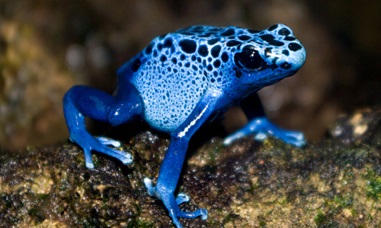The blue poison dart frog, scientifically known as Dendrobates tinctorius “azureus,” is a small and brightly colored frog native to the rainforests of Central and South America. These frogs are part of the Dendrobatidae family and are renowned for their vibrant blue skin, which serves as a warning to potential predators that they are highly toxic.
Key characteristics of the blue poison dart frog include:
- Coloration: The bright blue coloration of the skin is a distinctive feature. However, it’s important to note that the intensity of the blue hue can vary among individuals and populations.
- Size: These frogs are relatively small, with adults typically ranging from 1 to 2 inches (2.5 to 5 centimeters) in length.
- Toxicity: Blue poison dart frogs are one of the most toxic species of poison dart frogs. They obtain their toxicity from the alkaloids in their diet, primarily ants and other small invertebrates in their natural habitat. The toxins serve as a defense mechanism, deterring predators from attempting to eat them.
- Habitat: They are found in the tropical rainforests of Surinam, a country in northern South America. Their habitat includes leaf litter on the forest floor, and they are often associated with water sources such as streams and small pools.
- Behavior: These frogs are diurnal, meaning they are active during the day. They are known for their distinctive hopping gait and agility.
- Reproduction: The female lays her eggs in humid locations, such as on leaves or in plant axils. After hatching, the tadpoles are often transported to water by the female, where they undergo metamorphosis into frogs.
It’s worth noting that the toxicity of captive-bred blue poison dart frogs is significantly lower than that of their wild counterparts. This is because their toxicity is derived from their diet in the wild, and captive-bred frogs are usually fed a diet that lacks the specific toxic compounds found in their natural food sources.
